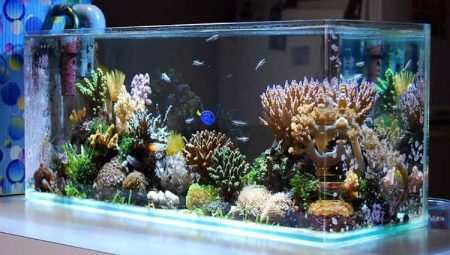Making an aquarium is no less exciting process than breeding the inhabitants of a home mini-pond. After all, it’s interesting not only to observe the underwater life, but also to create scenery for it with your own hands. It will be up to you with the wreckage of the legendary ship, or it may turn out to be a tank in the spirit of Japanese minimalism. There are a lot of options and ideas, and you can dilute this set with an individual style and a unique concept.
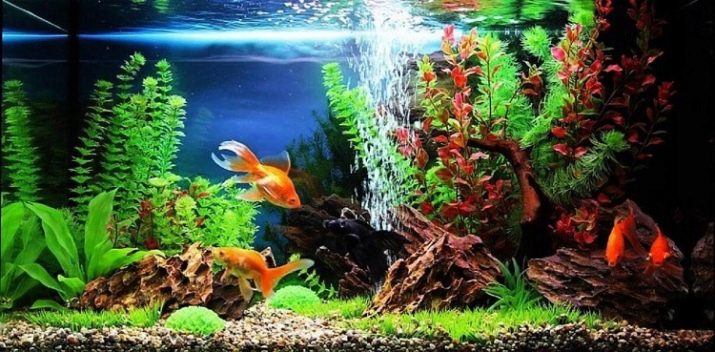
What materials can be used?
Those who just try themselves in aquascaping, evaluate the work of other masters, consider the pictures and often cannot believe that all this can be done with your own hands. The first step is to purchase an aquarium, the second is to develop a plan for decorating it. We recommend First, look at the many options that will create a certain base of aqua design, help you navigate in the direction that is most preferable for you.
Aquascaping has its own rules. The choice of style and composition is, of course, very important, but the design in the aquarium is always secondary. In the first place - the organization of optimal living conditions for underwater residents.
If something in the design of the aquarium disrupts the life of fish and other quick swimmers, you will have to part with an objectionable element.
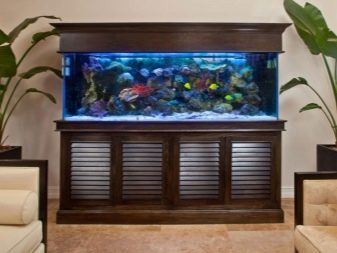

The basic materials for decoration include the following:
- metal;
- organics;
- glass and ceramics;
- rock and minerals;
- plastic, polystyrene and rubber.
Important! It is worth paying attention to how the material interacts with the natural environment of the aquarium.If it makes the tank more beautiful, but harms the bio-balance of the underwater kingdom, the material is not suitable.
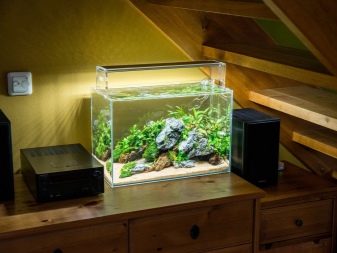
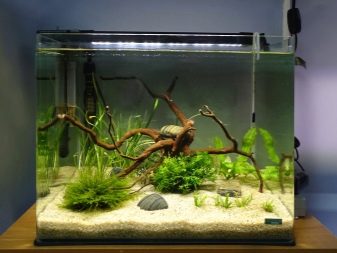
Most metal objects immersed in water are subject to oxidation, which can ruin the composition of the water. If the metal is covered with protective equipment, it no longer looks so dangerous. But varnishes and paints become covered with microcracks over time, which means that the water will still be contaminated with oxidation products. Fortunately, metal is not very actively used in the decoration of the aquarium. Basically, metal elements are part of filters and heaters.


Organics is, of course, driftwood and tree roots. They imitate the coastal sector of water bodies. Minerals and rocks are, first of all, stones that really often appear in tanks. Mosses are often grown on stones, which also adorns the container.
Quartz, syenite, as well as flint and basalt are well arranged in the mini-pond. They can be considered neutral with respect to the composition of water. The stones found in the natural environment should be prepared for launch into the pool - washed with a rough brush, kept in a separate container filled with aquarium water for a week. Cement and gypsum are chosen less frequently than, for example, ceramic pots. The latter turn over, chip off a piece so that the fish can swim inside.
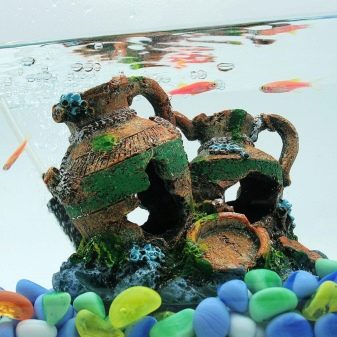

Choose an aquarium background
The most popular option for the back wall is considered laminated film, which depicts rocks, plants and other decorations. This film can be purchased by the size of the tank. The film gives the tank a more natural look, does not adversely affect the condition of the underwater inhabitants.
The background is one-sided and two-sided.
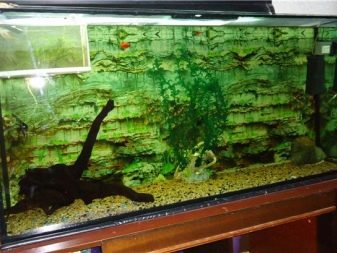
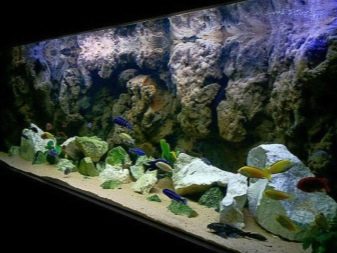
If you do not like the option of laminated film, pay attention to brown paper. It is suitable for creating your own backdrop. Often, aquarists use scrapbooking paper, which really uniquely results - the background is very unusual, stylish. If the background at all, you think, should be minimalistic, then you can cover it with a sheet of dark blue paper (or even paint over it simply).
But the back wall is usually not left transparent: there are shy fish that can be afraid of their own reflection.
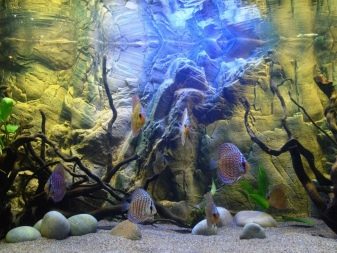
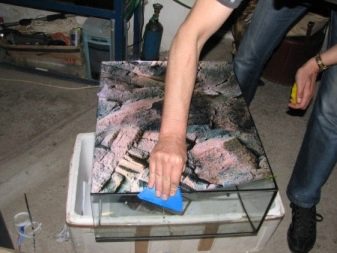
Varieties of soil
For aquarists demanding tank vegetation, the most important neutral soils. This, for example, river pebbles, coarse sand, crushed basalt and quartz. In this substrate, plant roots are fixed. Vegetable garbage is collected there, as well as the waste products of the inhabitants of the underwater kingdom.
If you ignore the soil layer, the water quickly becomes cloudy, algae multiply in it at a cosmic speed.
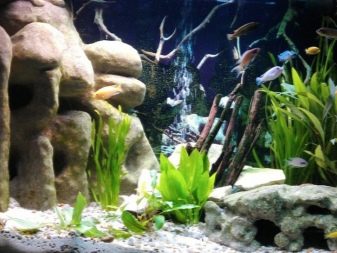
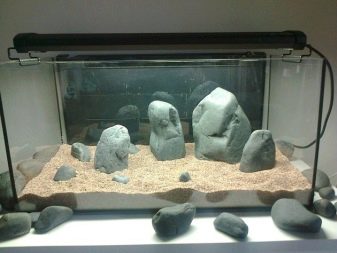
Nutrient soils represent either a vitamin substrate or granular land substance. If the substrate is laterite, it will be rich in iron, if it is peaty, it contains a lot of nitrogen and phosphorus, if clay, it is enriched with potassium. Certain species of fish live only in the sand, they even swallow quartz sand to improve digestion or dig into the sandy thickness for spawning. What is good about sand is that it makes the aquarium environment similar to the natural one. The roots of plants can firmly gain a foothold in the sandy substance, a fertile environment is formed in it.
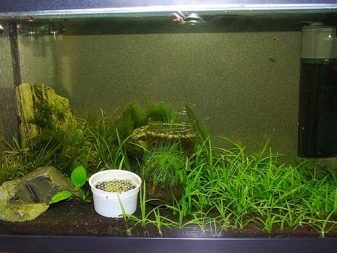

And there are black and white soils. Black is a purely decorative material (shugnite + basalt + granite). But he has a minus - water can turn gray. And granite also has magnetic properties, which are not always safe for fish. Therefore, the option of only quartz is the most optimal.
White soil easily soiled. For example, if you treat fish and send medicines with a dye in the water, they can paint over the soil. If you choose natural white soil, it is most likely limestone.It dissolves in water with the help of organic acids, which makes the water hard - and not all fish will like it.
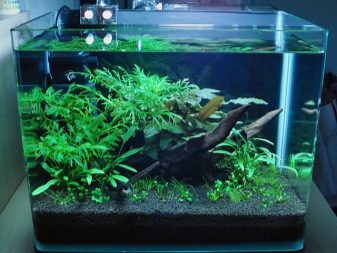
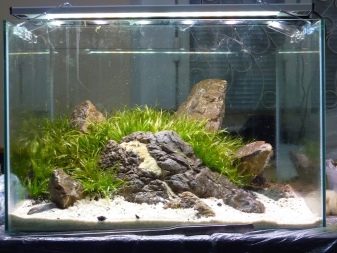
What stones are suitable?
Usually used for aquariums granite, solidified magma, quartz, petrified wood, slate and slate. It is worth noting large pebbles, but it still relates more to the soil than to decorative stones in an underwater house. Stones such as can be harmful:
- alabaster;
- marble;
- dolomite;
- limestone;
- coral;
- crushed shells;
- different types of sandstone.
These are carbonate rocks of stones, to make sure that the stone found belongs to them, apply a few drops of white vinegar to its surface. If the liquid began to hiss, bubble, there is carbonate in the rock. All stones need to be heat treated before being lowered into the aquarium. If the stone is heavy, do not apply it to the glass. This is a common mistake of beginner water designers: the glass of a tank can break under the pressure of large decorations.
Lay the stones evenly, do not pile them together.
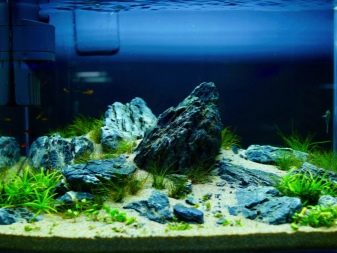

Wooden driftwood as an aquarium decor
If you have ever seen Japanese-style aquariums, you must have noticed how ordinary driftwood looks amazingly organic in a limited body of water. In fact, to create such a harmonious picture, you need to have a good artistic taste. The minimalism of underwater landscapes is so wonderful because there is nothing superfluous there, and everything available is carefully selected. Treat driftwood as responsibly as possible.
So that they take root in the aquarium and do not harm it, you need to choose hardwood, not coniferous, well boiled in salt water and dried in the sun. To decorate the tank, only a “dead" tree is used, which has lain in nature for a long time, getting rid of bark and juices. Rotten places on snags - a reason to abandon such organics.
If you yourself do not want to look for suitable patterns, you can buy a similar decor in a pet store.
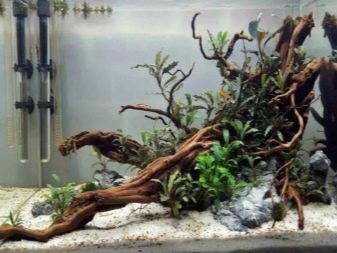
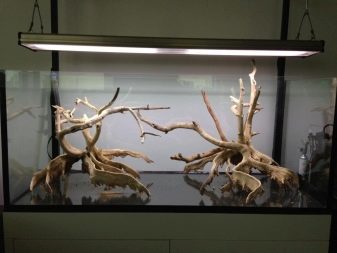
Live and artificial plants
Do not be afraid to use artificial flora in the aquarium. Many modern elements look so natural that you will never guess about their true origin. In addition, not all real plants are able to get along with the inhabitants of the aquarium, with the artificial flora of the fish come into conflict less often. If you make a rating of the most beautiful plants for a mini-pond, the following varieties will surely fall into it:
- cinnamon red;
- eriocaulon;
- krinum wavy;
- Wallisneria
- hygrophilic patterned;
- riccia;
- Javanese moss.
Artificial water lilies look great in an aquarium of different sizes and types. They make them colorful, expressive, catchy. Fish are indifferent to them - they do not touch, they do not spoil, but they can be used as shelters.
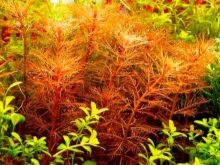
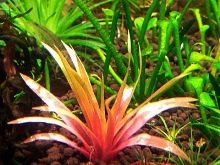
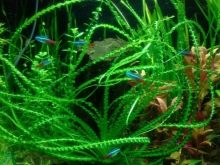
Shells and Corals
Try to buy such decorations only in specialized stores, and not in souvenir shops where such elements are varnished. By placing such a shell in the aquarium, you can poison the underwater inhabitants. In order to sanitize and process such decorations, it is worth performing actions such as:
- corals can be boiled in boiling water, then rinsed by wiping with a soft brush;
- shells with a mother-of-pearl surface cannot be boiled; for this purpose, they are usually left on the anthill for 4 hours to remove intra-shell remains;
- coral reefs are soaked in water for two weeks, occasionally updating the water.
Gorgonians are not suitable for the decor of an artificial pond: alas, they rot in fresh water.
Shells and corals lead to increased water hardness, which should be considered when choosing fish.
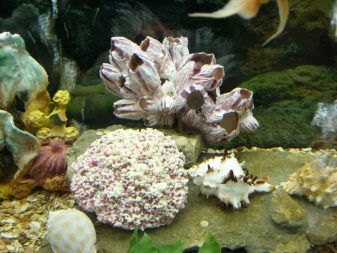
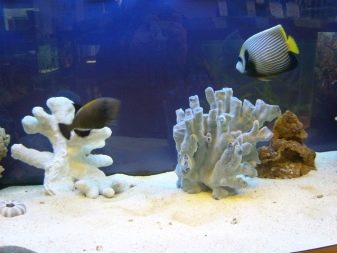
Other subjects
The decor of a mini-pond is often wrecks, covered with moss and algae, in the gaps of the windows of which chests of gold are visible. These are mermaids-sirens, which dragged more than one man into the whirlpool, these are underwater rocks and huge artificial crabs of bright colors.Original aquariums for those who invest in a design concept a certain artistic idea. Someone contains an herbalist aquarium exclusively, in which there are no living inhabitants, but impressive large black fish (artificial) swim or somewhere, at the very bottom, there is a persistent tin soldier.
Someone turns the herbalist into an underwater mermaid kingdom, where a whole family of mermaids lives, like a living personification of Andersen's famous fairy tale. Fancy and plastic jellyfish, coated with a special film for phosphorescence in the dark. A chest of pearls or a bottle in which an omnipotent gin can be hidden in underwater gardens.
Fairy theme in the design of aquariums is more than appropriate.
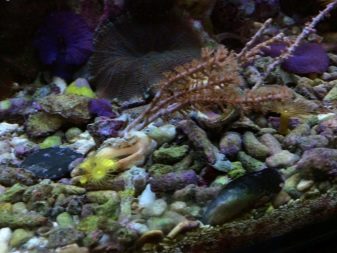
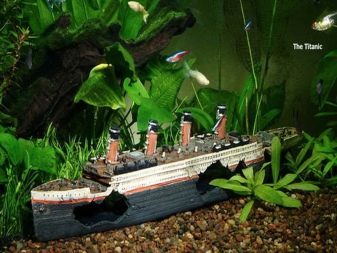
Jewelry selection
Think, maybe it’s worthwhile to design an aquarium in a well-recognized style, for example, in Egyptian. The background is designed in the form of mysterious images on the walls, in the tank itself there are pyramids, ruins and fragments of amphorae. In this style, orange soil options will organically look. For a small pool, minimalism is needed. If there is, for example, a sunken ship, you should not add other decorations to the bottom.
Ship will become the semantic center of the composition, the rest only plays along with him. Try to buy jewelry in specialized stores. Various toys may not be suitable for placement in water, especially the one where living creatures live.
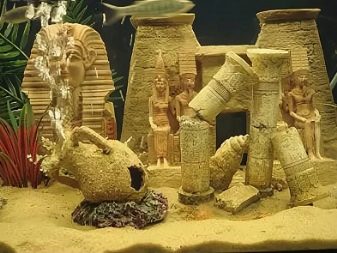

Use in design
It is very important how the aquarium will look in the interior. If you purchase it for children, it can become a good decoration in a nursery. But it is necessary that the children are adults and understand what is possible with regard to the aquarium and what is not. It is believed that starting from the age of 8, the child is already responsible for such a living corner and can, together with his parents, look after him, arrange the decor in it in places. If you want an aquarium in the nursery, where preschool children grow, recommends purchasing artificial, dry aquarium - It can also be decorated, it is interesting to arrange elements. This is a beautiful and safe decor in the nursery.
In the living room, you can also focus on the aquarium. With your own hands to design a backdrop, choose the right color scheme, establish good lighting - in a word, you can conjure with accents. He, the aquarium, will control the eyes of everyone who has entered the room. It is important to treat the tank outside so that it shines with cleanliness and freshness.. A couple of decorative stickers in the theme also will not hurt, for example, Ocean and National Geographic channel logo stickers. There are craftsmen gluing glass on the outside action figure of the famous Jacques Yves Cousteau, and it is really original.
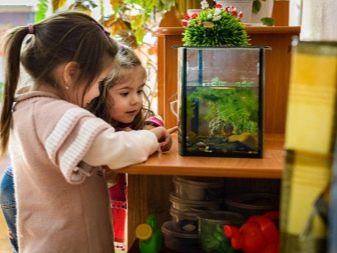
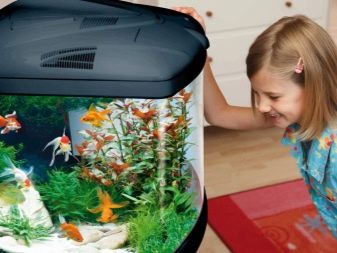
You can find out how to assemble an aquarium below.
